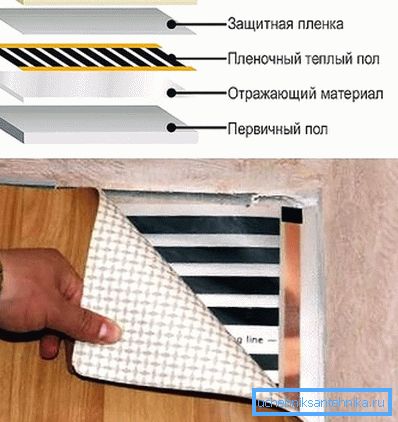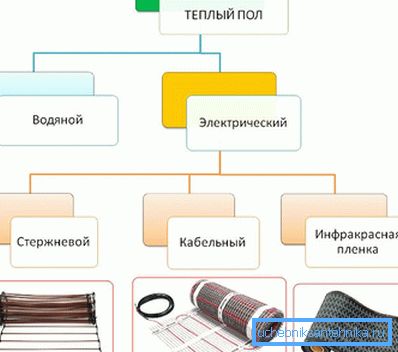How to lay a warm floor under the linoleum
Linoleum has a number of characteristics, including thermal conductivity. This property depends on the density of the material, its thickness and additional thermal insulation layer. If the lower room is residential and heated, and the floor is not cooled, the floor heating does not have such great importance. However, for private houses and cottages, rooms located on the first floor or children's rooms, a warm floor is a means of heating, a feeling of comfort and the ability to run barefoot, while maintaining their own health and the health of children. Since linoleum is used as a floor covering quite often, consider how to lay a warm floor under linoleum on your own.
Specifications

Linoleum is a flooring made from polymeric materials. 5 types of coatings are used, subdivided according to the binder material:
- Natural (marmoleum), - is made on the basis of linseed oil, pine resin, wood flour, lime powder, natural dyes
- Polyvinyl chloride (PVC) is the most common linoleum used for domestic and commercial purposes.
- Rubber (relin) is a material with a high degree of defomerability, but does not tolerate elevated temperatures.
- Nitrocellulose - based on the product is a polymer made from nitrocellulose, characterized by a high degree of flammability.
- Alkyd - produced on alkyd components, has good performance on heat and sound insulation, prone to the formation of residual deformation - stretches during operation.
PVC-based household flooring is a mass flooring used for laying in residential areas. Differs in its consumer properties and the price available to a wide range of buyers.
Modern types of linoleum are designed with the ability to operate in conjunction with heating systems. For example, the products of one of the manufacturers of floor coverings, which occupy a large part of the market, allow the use of heated floors with a maximum heating temperature of up to + 27 ° C. Excess of these indicators over a long period of time can lead to changes in the strength and elastic properties of linoleum - it will be deformed, become rigid and brittle.
How to make a warm floor to avoid such negative effects? Make the right choice of the heating system and its installation in accordance with the recommendations of the manufacturer.
Types of warm floors under linoleum

Two types of heating are applied:
- the main coolant is hot water;
- heat source - materials that convert electricity into heat, for example, wires, plates or films.
Water

This design has a number of undoubted advantages:
- safe to use;
- economically more profitable compared to other types of heating systems.
Minuses:
- complex installation - requires the laying of an additional concrete tie, it is necessary to arrange the pipes;
- due to the temperature difference between the coolant at the inlet and outlet of the heating system is uneven heating;
- has a certain inertia - the acquisition of the required temperature is carried out with a delay of up to 10-20 minutes.
Electric

Under the linoleum is most convenient to lay the system, made in the form of film or sheet heaters.
Benefits:
- They take a small distance in height, up to 5–8 mm. Lead wires and temperature controllers can be laid in prepared recesses to prevent height differences - it is easier to lay linoleum on such a surface.
- Simple installation - it is enough to lay mats or sheets on a pre-mounted thermal insulation substrate.
- The speed of response to changes in temperature conditions, according to the incoming commands from the thermal control system.
Disadvantages:
- Higher power consumption for floor heating than a water heating system.
- If the floor heating system malfunctions, there is a risk of overheating of linoleum. This can cause the formation of irreversible deformations and changes in the technical characteristics of the flooring. In addition, the release of harmful substances caused by high temperatures is likely.
Installation of an electric floor is carried out according to the recommendations given in the instructions for the product. If you still have questions on the topic, then ask them to the specialist working on the site, write comments to the article.
We also recommend that you read:
- Using cross-linked polyethylene in a warm field.
- Infrared warm floor.
- Installation of the circulation pump for heating.
- How to remove the air from the heating.
Video
This video describes how to install infrared heating for linoleum: